
Valletta is the capital city of Malta. Located in the South Eastern Region of the main island, between Marsamxett Harbour to the west and the Grand Harbour to the east, its population in 2014 was 6,444, while the metropolitan area around it has a population of 393,938. Valletta is second only to Nicosia as the southernmost capital of Europe, and at just 0.61 square kilometres (61 ha), it is the European Union's smallest capital city.

St John's Co-Cathedral is a Roman Catholic co-cathedral in Valletta, Malta, dedicated to Saint John the Baptist. It was built by the Order of St. John between 1572 and 1577, having been commissioned by Grand Master Jean de la Cassière as the Conventual Church of Saint John.
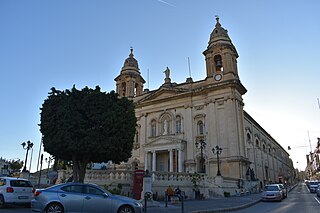
Marsa is a town in the South Eastern Region of Malta, with a population of 4,401 people as of March 2014. The name Marsa means "the harbour".

City Gate is a gate located at the entrance of Valletta, Malta. The present gate, which is the fifth one to have stood on the site, was built between 2011 and 2014 to designs of the Italian architect Renzo Piano.
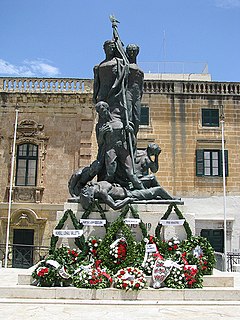
Sette Giugno is a Maltese national holiday celebrated annually on 7 June. It commemorates events which occurred on that day in 1919 when, following a series of riots by the Maltese population, British troops fired into the crowd, killing four. This led to increased resistance to the colonial government and support for the pro-Italian irredentists that had challenged the British presence on the island.

Saint James Cavalier is a 16th-century cavalier in Valletta, Malta, which was built by the Order of St John. It overlooks St James' Bastion, a large obtuse-angled bastion forming part of the Valletta Land Front. St James was one of nine planned cavaliers in the city, although eventually only two were built, the other one being the identical Saint John's Cavalier. It was designed by the Italian military engineer Francesco Laparelli, while its construction was overseen by his Maltese assistant Girolamo Cassar. St James Cavalier never saw use in any military conflict, but it played a role during the Rising of the Priests in 1775.
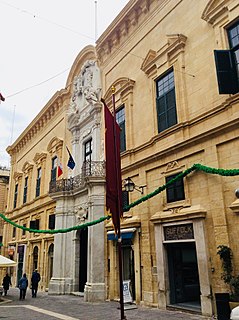
The Castellania, also known as the Castellania Palace, is a former courthouse and prison in Valletta, Malta. It was built by the Order of St. John between 1757 and 1760, on the site of an earlier courthouse which had been built in 1572.
Maltese literature is any literature originating from Malta or by Maltese writers or literature written in the Maltese language.
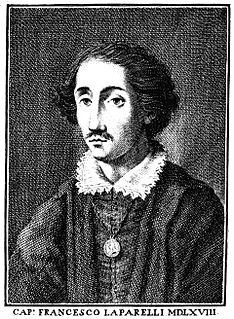
Francesco Laparelli da Cortona was an Italian architect. He was an assistant of Michelangelo, and later was sent by the Pope to supervise the construction of Valletta in Malta.

The Auberge d'Auvergne was an auberge in Valletta, Malta. It was built in the 16th century to house knights of the Order of Saint John from the langue of Auvergne. It became a courthouse in the 19th century, and it remained so until it was destroyed by aerial bombardment in 1941. The site is now occupied by the Courts of Justice building, which was constructed in the 1960s.

The Auberge d'Italie is an auberge in Valletta, Malta. It was built at various stages in the late 16th century to house knights of the Order of Saint John from the langue of Italy, and it originally had a Mannerist design by Girolamo Cassar and several other architects. The building continued to be modified throughout the course of the 17th century, with the last major renovation being carried out in the 1680s during the magistracy of Gregorio Carafa, giving the building a Baroque character.
Girolamo Cassar was a Maltese architect and military engineer. He was the resident engineer of the Order of St. John, and was admitted into the Order in 1569. He was involved in the construction of Valletta, initially as an assistant to Francesco Laparelli, before taking over the project himself. He designed many public, religious and private buildings in the new capital city, including Saint John's Co-Cathedral, the Grandmaster's Palace and the auberges. He was the father of Vittorio Cassar, another architect and engineer.

Saint John's Cavalier is a 16th-century cavalier in Valletta, Malta, which was built by the Order of St. John. It overlooks St. John's Bastion, a large obtuse-angled bastion forming part of the Valletta Land Front. St. John was one of nine planned cavaliers in the city, although eventually only two were built, the other one being the identical Saint James Cavalier. It was designed by the Italian military engineer Francesco Laparelli, while its construction was overseen by his Maltese assistant Girolamo Cassar.

The Valletta Summit on Migration, also called the Valletta Conference on Migration, was a summit held in Valletta, Malta, on 11–12 November 2015, in which European and African leaders discussed the European migrant crisis. The summit resulted in the EU setting up an Emergency Trust Fund to promote development in Africa, in return for African countries to help out in the crisis.
Andrea Belli was a Maltese architect and businessman. He designed several Baroque buildings, including Auberge de Castille in Valletta, which is now the Office of the Prime Minister of Malta.
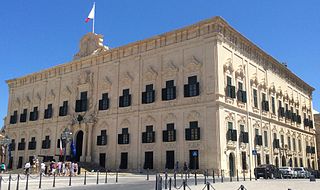
Domenico Cachia was a Maltese capomastro who was involved in the construction of several notable buildings, including Auberge de Castille in Valletta and St Helen's Basilica in Birkirkara. It is not certain if he was the same person as Gio Domenico Cachia, an architect who was the father of Antonio Cachia.

Ġnien is-Sultan, also known as the Giardino della Marina, the Grand Master's Garden or Lascaris Garden, was a garden in Valletta, Malta. It was established in the 17th century by Giovanni Paolo Lascaris, and it included a summer residence for the Grand Master. The garden included several Baroque elements designed by Francesco Buonamici.

The Forni della Signoria was a bakehouse in Valletta, Malta. It was constructed in the late 16th century by the Order of St John, and it consisted of a number of bakeries which produced bread for the inhabitants of Valletta and the surrounding area, as well as for the Order's garrison and navy.

Maltese Baroque architecture is the form of Baroque architecture that developed in Malta during the 17th and 18th centuries, when the islands were under the rule of the Order of St. John. The Baroque style was introduced in Malta in the early 17th century, possibly by the Bolognese engineer Bontadino de Bontadini during the construction of the Wignacourt Aqueduct. The style became popular in the mid to late 17th century, and it reached its peak during the 18th century, when monumental Baroque structures such as Auberge de Castille were constructed.





















